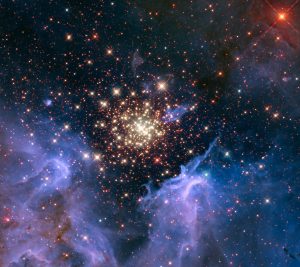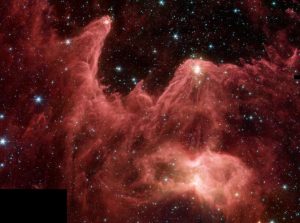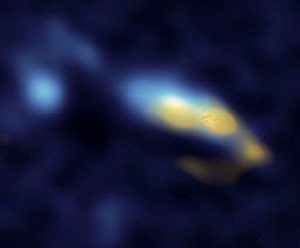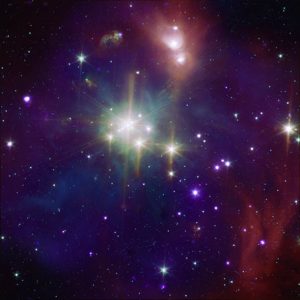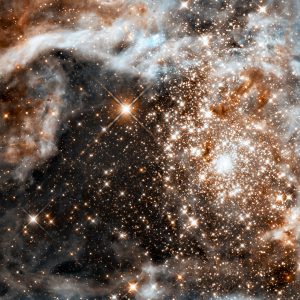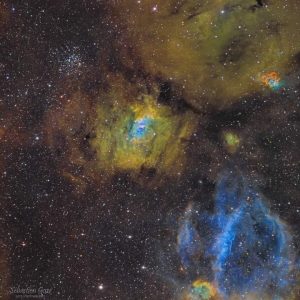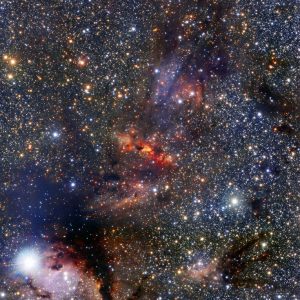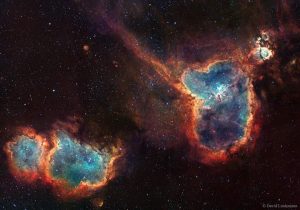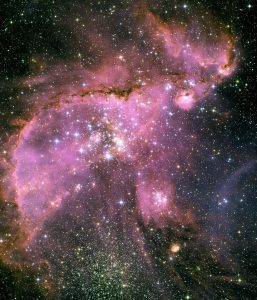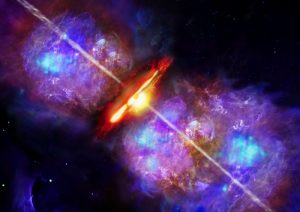stelle massicce
Scintillio di Stelle
Una giovane, scintillante collezione di stelle si presenta come uno spettacolo celeste di fuochi d’artificio. L’ammasso è circondato da nubi di gas e polveri interstellari, la materia prima per la formazione di nuove stelle. La nebulosa, che si trova a 20.000 anni luce di distanza nella costellazione della Carena, contiene un ammasso centrale di stelle ardenti e massicce, chiamato NGC 3603. Continua a leggere
Montagne della Creazione
In questa maestosa immagine ripresa dal telescopio Spitzer possiamo ammirare pilastri simili a montagne dove nascono stelle. Soprannominate “Montagne della Creazione”, queste colonne di gas freddo e polveri sono illuminate sulla sommità dalla luce di calde stelle neonate. Continua a leggere
Polvere di Stelle
Le galassie sono una collezione di brillanti stelle, ma contengono anche polveri e gas. Un team guidato da astronomi dell’University of California ha utilizzato nuovi dati per dimostrare che le stelle sono responsabili della produzione della polvere su scale galattiche. La polvere è importante perché costituisce un componente chiave di pianeti rocciosi come la Terra. La ricerca è stata pubblicata su Astrophysical Journal Letters. Continua a leggere
Splendore stellare nell’Ammasso Coronet
Anche se forse non è così conosciuta come Orione, la regione della Corona Australe (contenente nel suo cuore l’Ammasso Coronet) è una delle più vicine e più attive zone di formazione stellare. Ad una distanza di circa 420 anni luce, l’ammasso è oltre tre volte più vicino alla Terra di quanto lo sia la nebulosa di Orione. Continua a leggere
Stelle titaniche in 30 Doradus
Il giovane, massiccio ammasso stellare, chiamato R136, ha un’età di soltanto pochi milioni di anni e risiede nella nebulosa 30 Doradus, una turbolenta regione di formazione stellare nella Grande Nube di Magellano, una galassia satellite della nostra Via Lattea. Continua a leggere
NGC 7635: Una Bolla in un Mare Cosmico
Astronomy Picture of the Day
2016 November 23
Al centro di questa spettacolare immagine è ben visibile una sfera simile ad una bolla di sapone cosmica, che sembra quasi alla deriva in un mare di stelle e di gas colorato incandescente. Questa delicata, fluttuante apparizione si chiama, in modo assai appropriato, Nebulosa Bolla (Bubble Nebula), catalogata NGC 7635. Continua a leggere
Nube a sorpresa
Questa immagine sorprendente mostra una zona della Via Lattea che si trova all’interno della costellazione dello Scorpione, vicino al piano centrale della galassia. La regione ospita una densa nube di gas e polveri associata alla nube molecolare IRAS 16562-3959, ben visibile come macchia arancione in mezzo al ricco raggruppamento di stelle nel centro. Continua a leggere
Le Nebulose Cuore e Anima
Astronomy Picture of the Day
2016 November 16
Le Nebulose Cuore e Anima
Il cuore e l’anima della nostra galassia si trovano in Cassiopea? Probabilmente no, ma è il luogo in si possono individuare due brillanti nebulose a emissione chiamate con i nomi poetici di Cuore e Anima. Continua a leggere
Giovani stelle creano sculture artistiche
Questa spettacolare immagine ripresa dal telescopio spaziale Hubble rivela i dettagli di una delle regioni di formazione stellare più dinamiche e complesse nello spazio, a 210.000 anni luce di distanza nella Piccola Nube di Magellano, una galassia nelle vicinanze della Via Lattea. Continua a leggere
Giovani stelle esplosive
Un team internazionale di scienziati guidato da Alessio Caratti o Garatti del Dublin Institute for Advanced Studies (Ireland) ha osservato e analizzato per la prima volta un outburst, un’esplosione generata da un giovane oggetto stellare di grande massa e provocata da materiale in caduta nella stella in formazione. Il team ha combinato immagini di SOFIA con quelle di altri osservatori (Gemini Observatory, ESO/VLT, Calar Alto Observatory, and ESO/MPG), analizzando una stella 20 volte più massiccia del Sole. Continua a leggere
